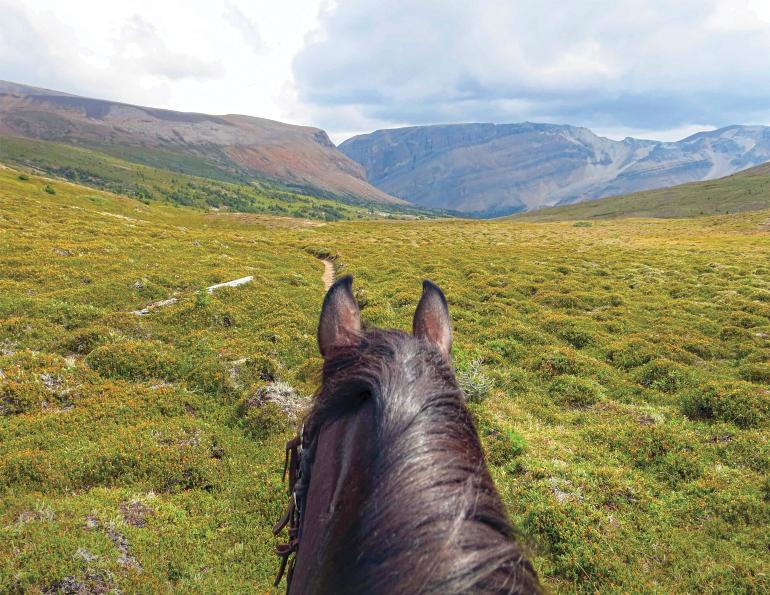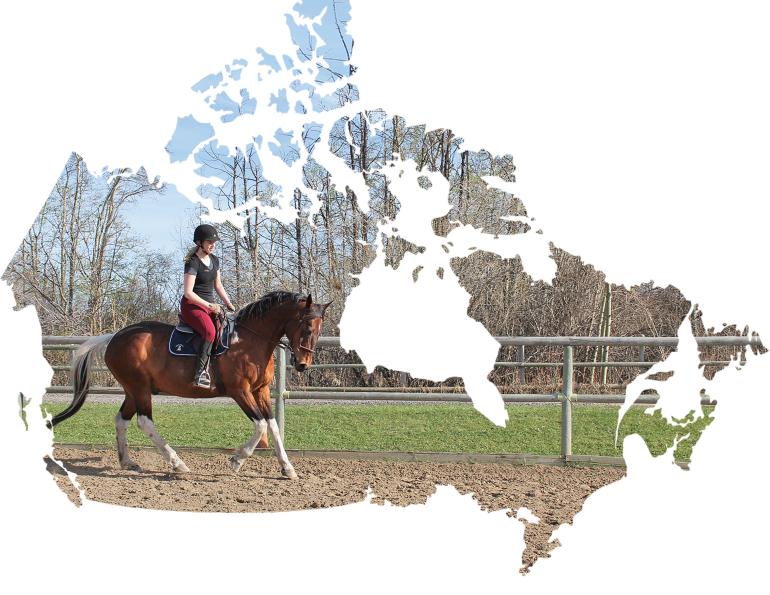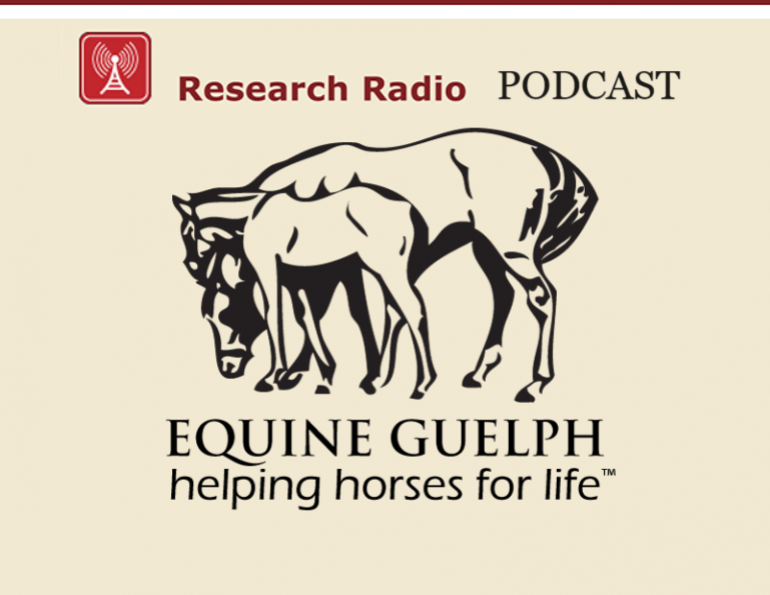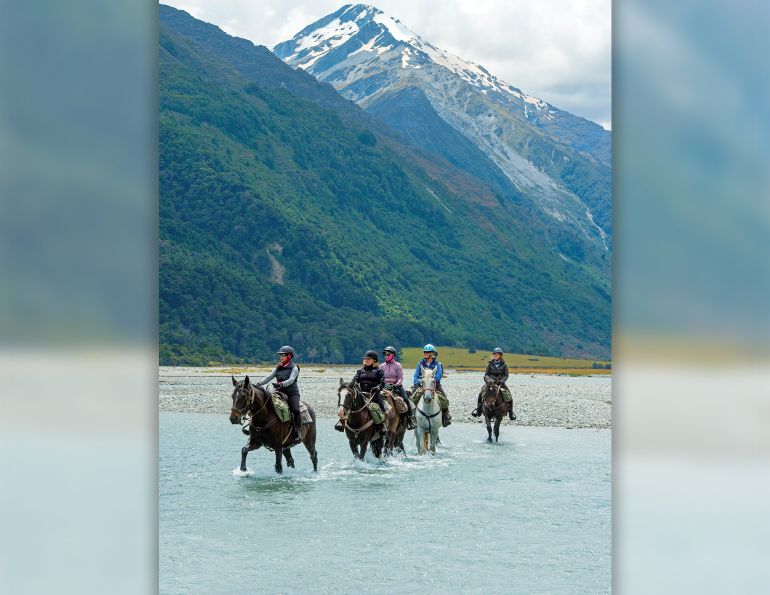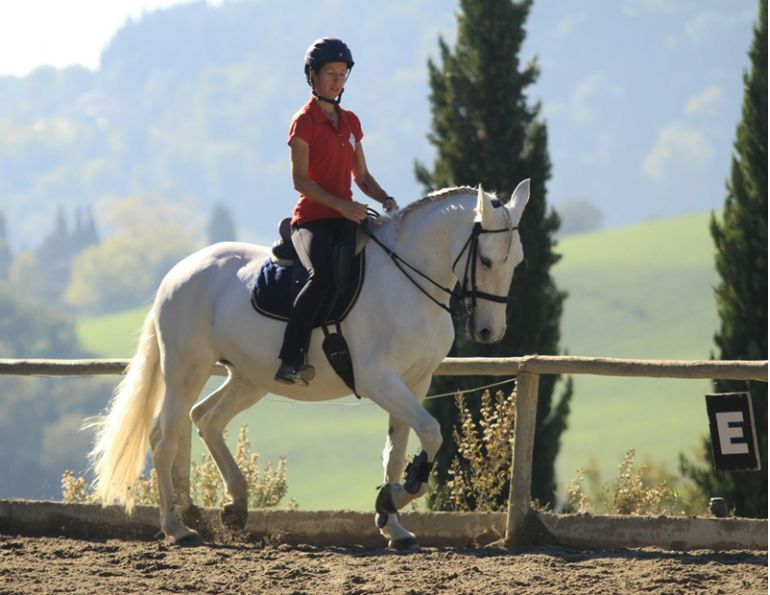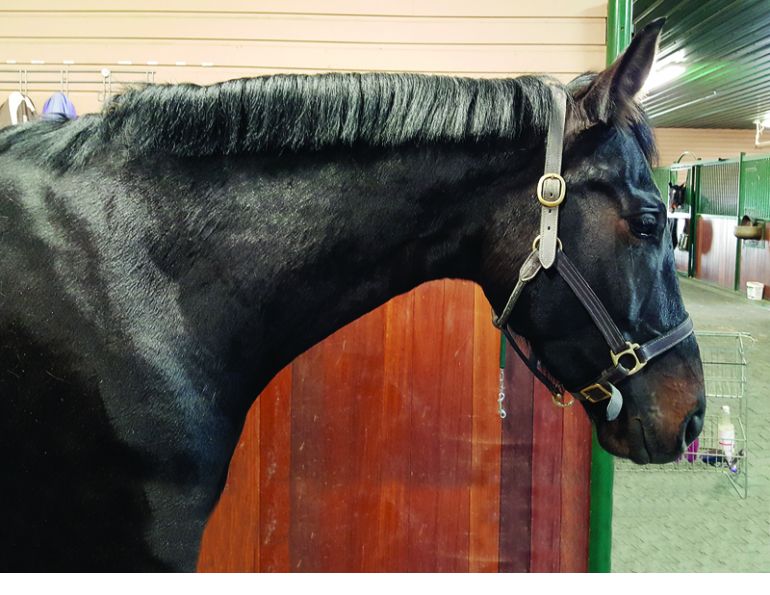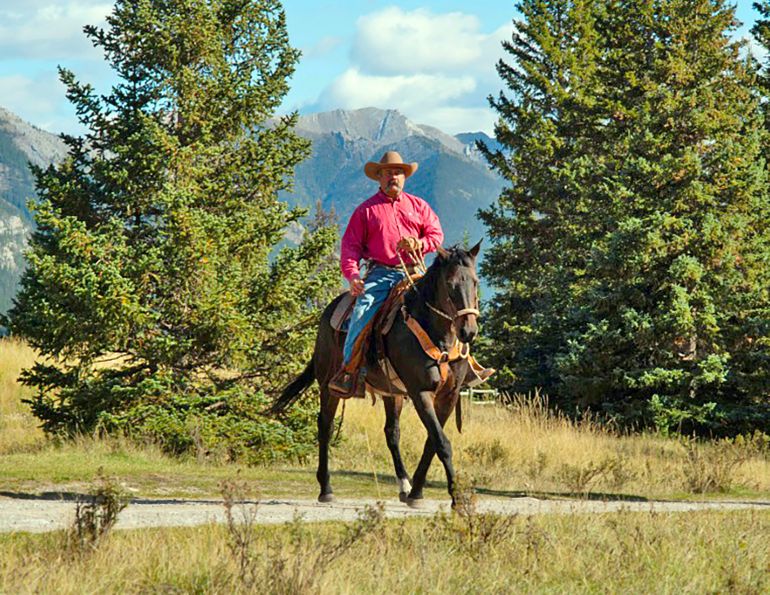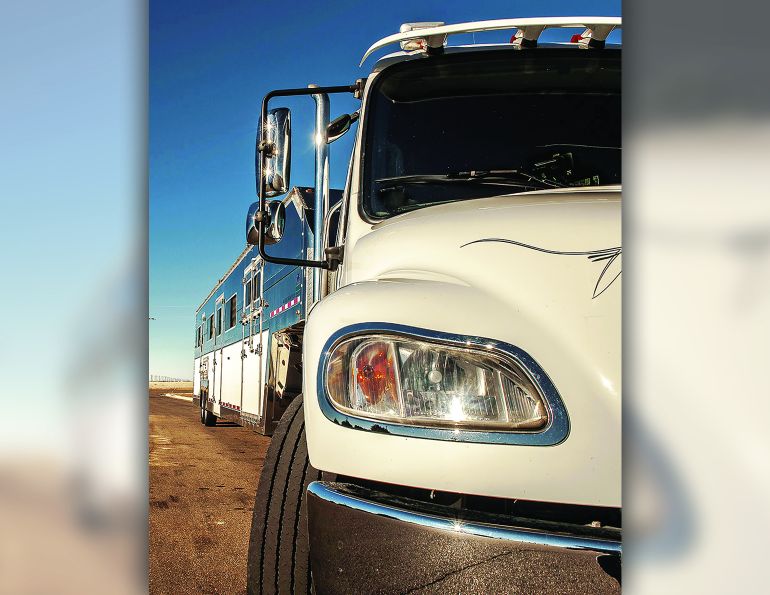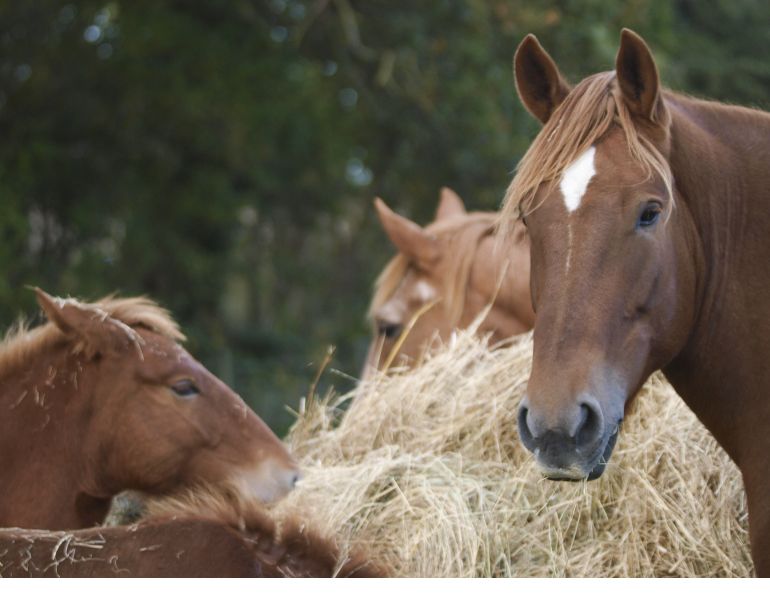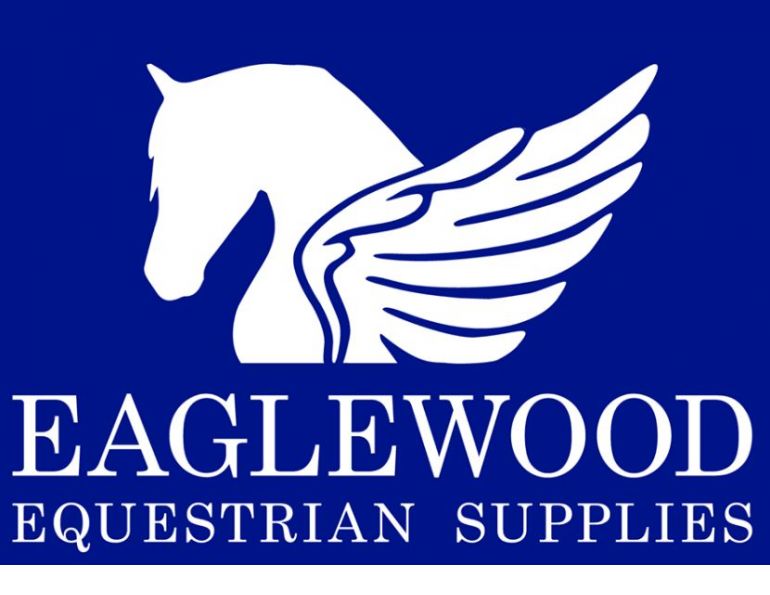By Tania Millen, BSc, MJ
Spending all day with your horse, visiting with friends, and riding a variety of trails pretty much describes horse camping, so it’s no surprise that many riders consider horse camping to be the ultimate adventure. Although performance riders often haul to a different facility for a clinic or competition, put their horse in a stall, and camp out in their rig, trail rider-style horse camping is a bit different.
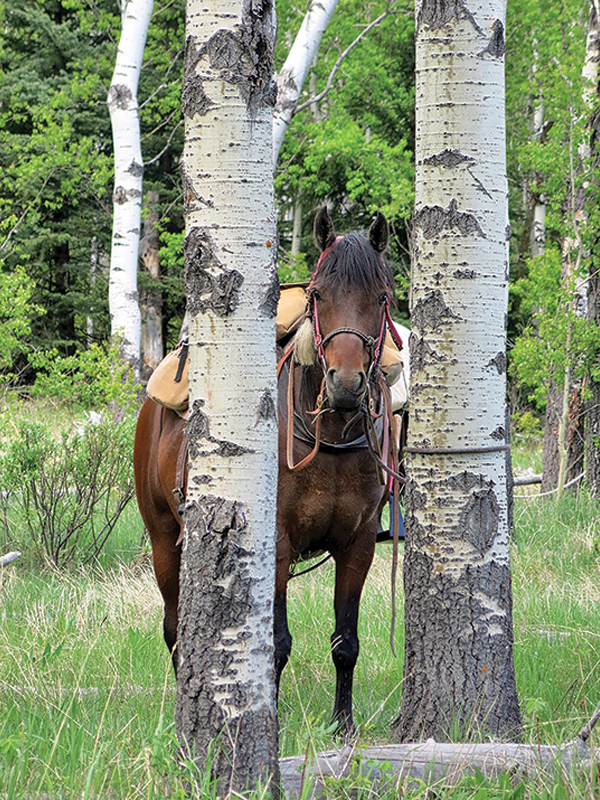
For trail riders, horse camping means hauling to a horse-friendly campsite or trailhead, setting up some sort of horse accommodation, and camping for a few days while riding the surrounding trails. The “facilities” may be nothing more than a parking spot, so horses and riders often need specialized skills and equipment, plus a willingness to make-do with whatever is available.
This article focuses on the essentials of horse camping so that any rider can get out there and join the fun. There’s lots to think about: where to go; how to get ready; set-ups for sleeping, eating, and accommodating horses; what to take; how to stay safe; and what trail riding gear to use. These topics are all discussed below.
Where To Go
Canada has plenty of horse campsites and trails. Many parks, public lands, private ranches, and bed, bale and breakfast operations (BBBs) cater to horse campers. To find them, contact regional and provincial equine organizations, talk to friends, research online, and hit up social media. A few horse campsites are listed below to get you started.
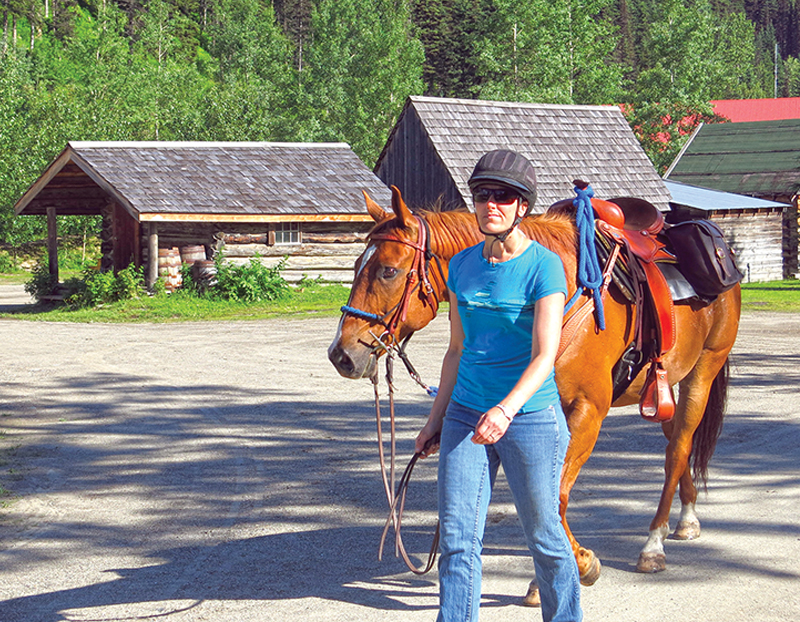
For your first horse camping experience, choose to go somewhere close by, use the gear you already have, and make sure both you and your horse are fit and ready for the adventure.
Get Ready
Before loading up and going camping, ensure that you and your horse are ready.
- Make sure your truck and trailer are well-maintained.
- Decide how you’re going to sleep and eat. Practice new camping and cooking skills at home.
- Figure out your horse’s accommodation and train your horse with any new systems.
- Expose your horse to unusual apparitions so that new experiences are less stressful. Trails and campsites have all sorts of strange things such as creeks, bridges, flapping flags, bicycles, and ATVs.
- Check that your horse is sound, healthy, up-to-date with vaccinations, deworming, and hoof care, plus fit for the riding you’ve planned. A Coggin’s test may be needed, too.
- Train your horse to travel quietly, settle in quickly, and eat and drink at every opportunity.
- Riding and caring for horses is tiring, so ensure you’re fit enough for the trip.
- Navigating new trails and country – or just finding the campsite - may mean using maps, a compass, or GPS. Learn navigation skills before you go.
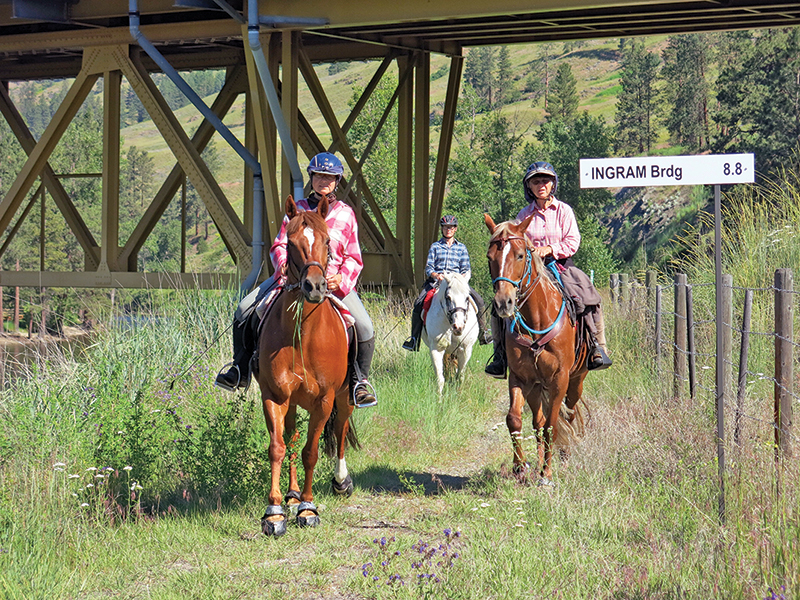
Riding with friends is not only safer, it’s more fun!
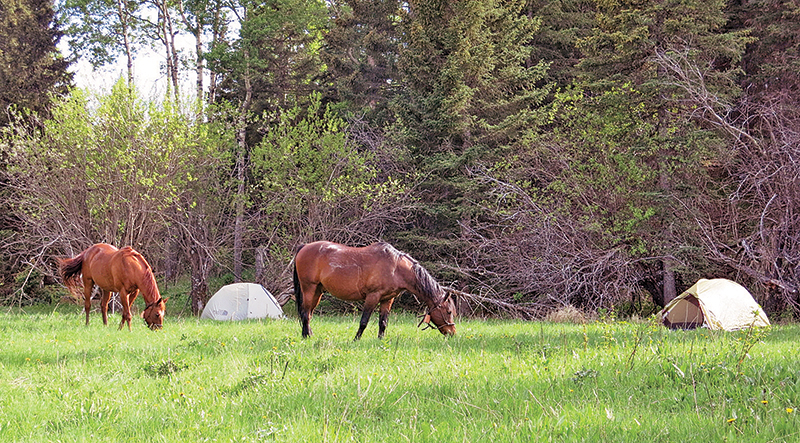
Belled horses rest and graze near tents.
Related: Hoofprints on the Cypress Hills
Camping and Horse Accommodation
Everyone has their preferred way to horse camp. I generally sleep on a cot in my bumper-pull stock trailer, cook on a miniscule camping stove, and store perishables in a cooler. It’s easy, inexpensive, and definitely not fancy. Some enjoy tenting, while others have weekender or living quarters gooseneck trailers configured for sleeping, cooking, and food storage. For more luxurious options, consider going to a take-your-own-horse ranch or BBB.
There are many ways to safely contain your horse, too. High-lining, electric fences, horse trailer tie arms, portable panels, and onsite paddocks or standing stalls are all typical options. High-lining includes tying your horse to a rope strung between two trees or posts. Trailer arms are tying systems permanently attached to your horse trailer. Electric fence pens or portable panels can be attached to the trailer or free-standing. Permanent paddocks or stalls provided by the campsite are easy options that most horses are familiar with.
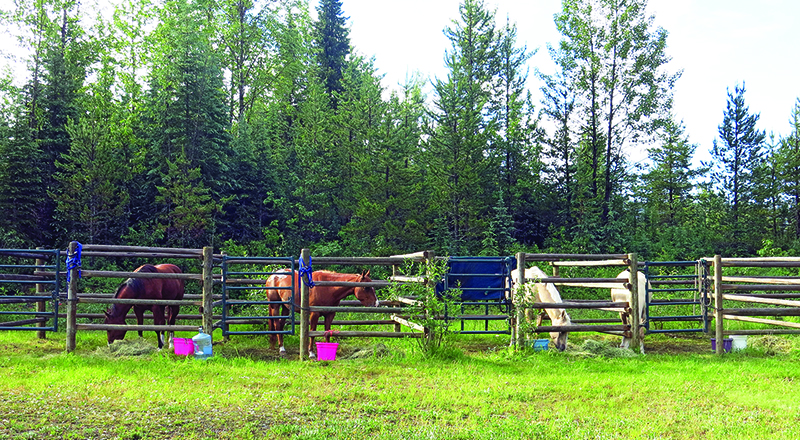
Many campsites have horse pens and water available.
Not every horse campsite allows high-lining or electric fences, or has permanent pens, power, or potable water. Where you choose to go horse camping will partly depend on how you and your horse prefer to camp and the skills and gear you have. You’ll have more campsite options if you and your horse are comfortable with different accommodation systems.
What To Take
The amount of gear needed for horse camping trips can be intimidating, so for each trip it’s useful to make personalized checklists which reflect your set-up and horse’s accommodation. Here’s an overview:
- Truck, trailer and travelling gear for you and your horse.
- Rider accommodation, camping, and sleeping gear.
- Riding and non-riding clothes.
- Food and potable water.
- Horse accommodation, feed, water, buckets, manure removal equipment.
- Horse tack and wear.
- Spares, emergency kits, first aid.
- Electronic gadgets, communications, navigation equipment, emergency contacts.
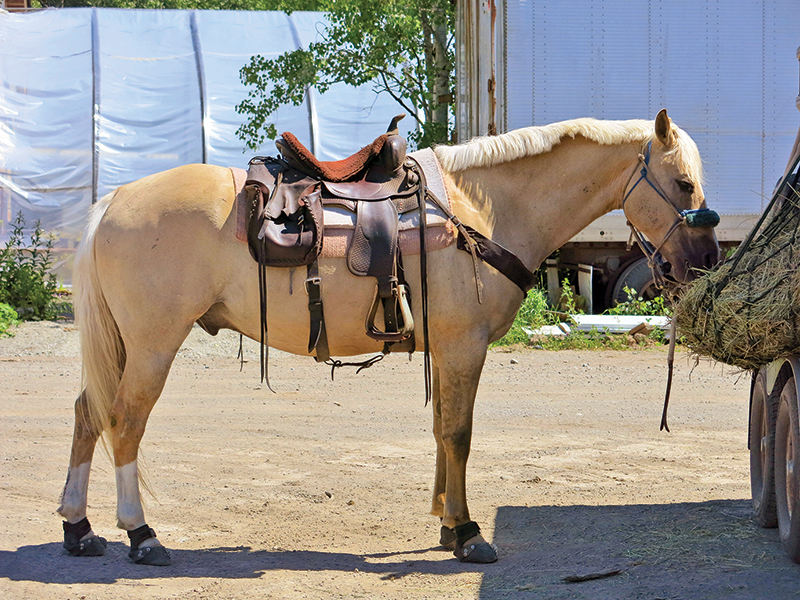
This lovely gelding is ready to take his rider down the trail.
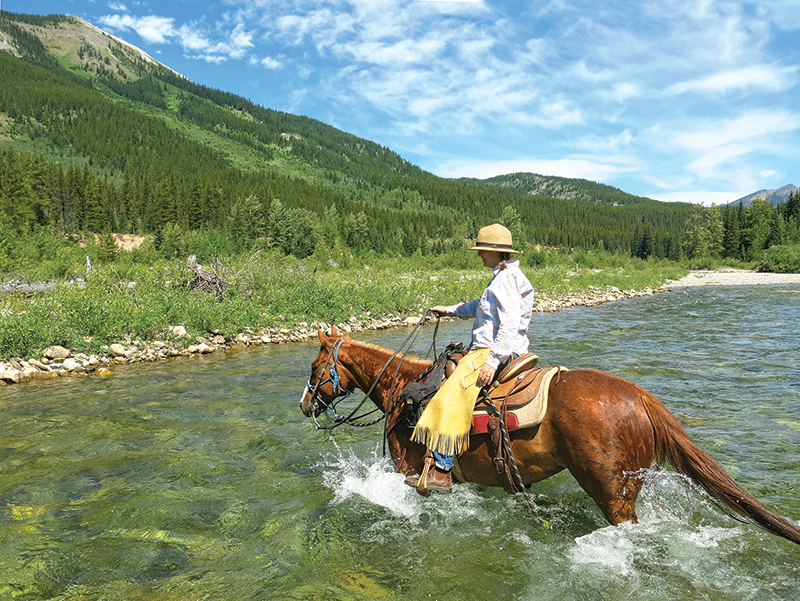
New experiences are part of the fun.
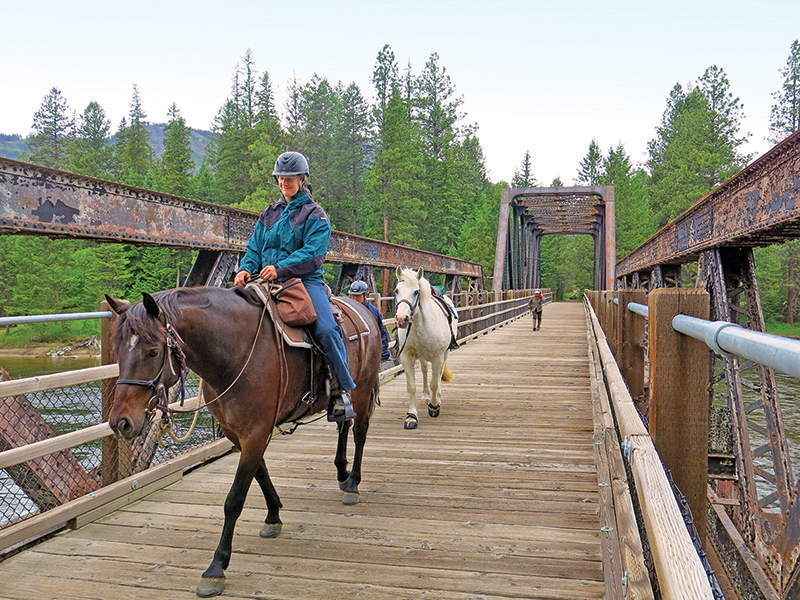
Your horse will have many new experiences, so the more situations you can get him used to before you go camping, the lower your stress levels will be.
Related: Riding Through Writing-on-Stone on Horseback
Stay Safe
The best way to stay safe is to prepare for potential problems and plan how you’ll deal with them. Know what to do if your truck or trailer breaks down, you get lost driving or riding, your horse gets loose or loses a shoe, you or your horse become injured, or you receive unwanted attention from strangers.
Have emergency plans for travelling and riding. Carry a communication device and know how to use it. Take written emergency contact information for the area you’re travelling and riding in. Tell someone where you’re going and when you plan to return. Advise your contact what to do if you don’t return when planned. When you return, report in to your contact person. Being prepared will help keep you safe.
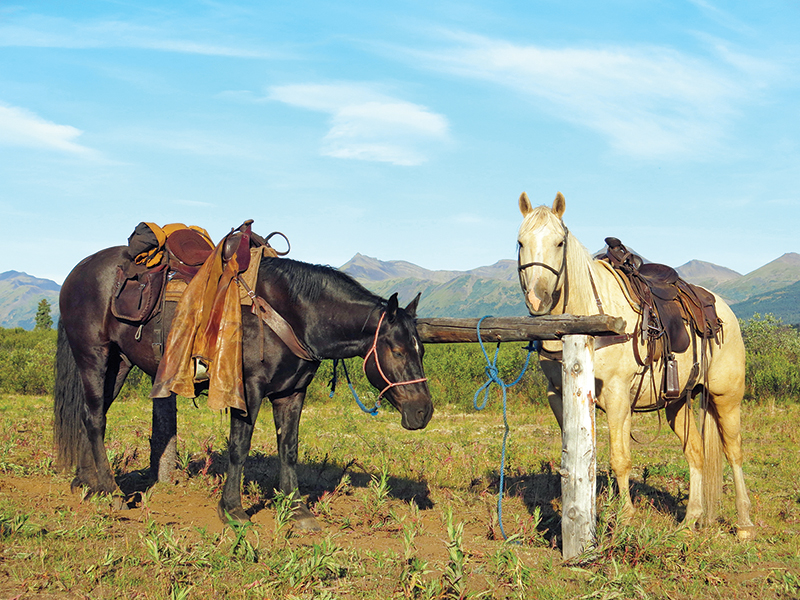
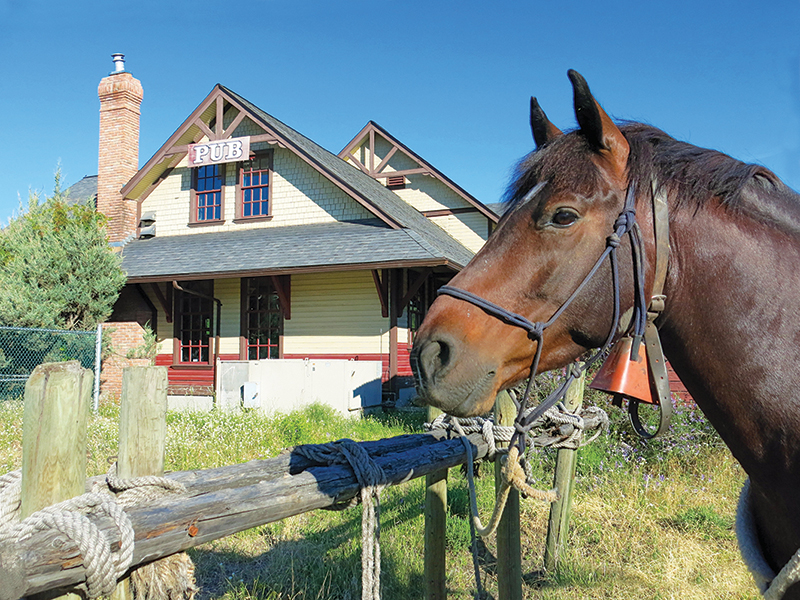
Before going camping, train your horse to settle in quickly and to tie quietly wherever needed.
Trail Riding Gear
Having the right trail riding gear makes a big difference. Here are some suggestions.
Western saddles distribute weight across a larger area of the horse’s back and are designed for longer riding times, so they’re a good choice for trail riding. Lighter saddles are less dead weight for your horse to carry, so a lighter saddle is preferred.
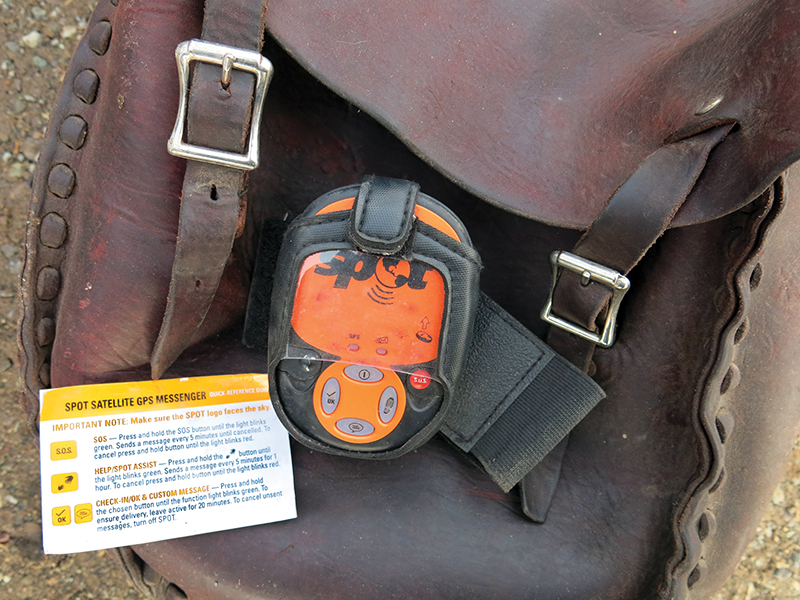
The SPOT™ Satellite GPS Messenger for personal satellite messaging and emergency communications uses 100 percent satellite technology, and works anywhere in the world, including where cell phones don’t.
A halter beneath the bridle allows horses to be tied up or led, if needed.
Breastplates prevent saddles from slipping back when riding uphill; rear cinches prevent the cantle from tipping up when riding downhill. Both are worth using.
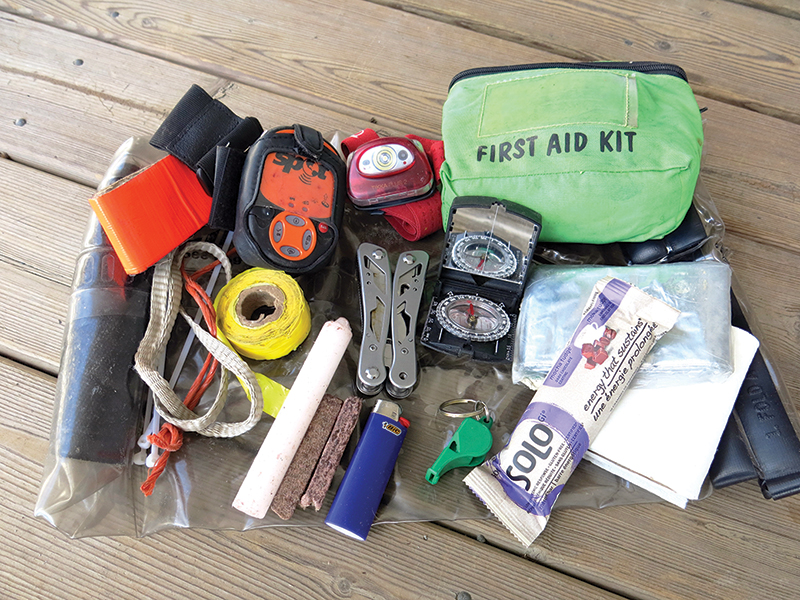
The essentials of an emergency kit.
Depending on the ride, consider carrying food and water, navigation tools (GPS, map), sunscreen, bug dope, hobbles, spare hoof boot, axe and handsaw in scabbards, rain gear, extra sweater and gloves, camera, binoculars, bear spray, and noise-makers.
An emergency kit’s useful, too, and should contain:
- A fix-it kit (multi-tool, binder twine, duct tape, zip ties).
- First aid kit, communication devices (whistle, cell phone).
- Trail re-finding tools (compass, flagging tape).
- Fire starter kit (starter sticks, candle, lighter); and
- Gear for an unintentional night out (head lamp, space blanket, food bar, toilet paper).
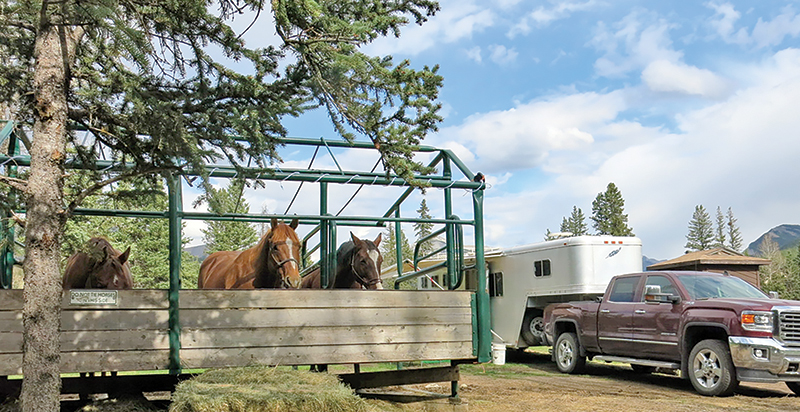
Standing stalls at a horse-friendly campground.

Orange lillies provide a striking contrast in a burnt forest.
Additionally, it’s highly recommended to carry a knife, lighter, and emergency device (SPOT™ beacon, InReach™) on your person at all times while riding. Then if your horse gallivants down the trail without you, you can help yourself plus request assistance.
Now that you’re ready, where are you going first?
Horse Campsites
Here are some horse camping locations that many riders enjoy. There are lots more.
British Columbia
Churn Creek Provincial Park is located 90 km northwest of 70 Mile House, adjacent to Empire Valley Ranch. Access is via steep, windy gravel roads, which can be slick. Pens are available. Riding is across grassland plateaus. www.env.gov.bc.ca/bcparks
Lundbom Lake is located 20 km southeast of Merritt, off Highway 97C (Merritt-Kelowna Connector). Lakeside pens, plus grassland and forested trails are available. www.SitesAndTrailsBC.ca
Wells Grey Provincial Park is located 30 km north of Clearwater, off Highway 5. Wells Grey Golf Resort has pens with campsites. Ride from camp onto forested wilderness trails. www.WellsGrayGolfResortandRVPark.com and www.env.gov.bc.ca/bcparks
Alberta
There are many campsites along the Rocky Mountains Eastern Slopes, including Crescent Falls, Dawson, Etherington, Honeymoon Creek, Indian Graves, Little Elbow, Mesa Butte, Bluerock, Sandy McNabb, Strawberry, and Whitehorse. Campsites have a variety of amenities. www.AlbertaParks.ca
Rock Lake in Willmore Wilderness Park is located 70 km northwest of Hinton, and is a staging area for day rides and backcountry trips. Pens, water and camping are available. www.AlbertaParks.ca
Ya Ha Tinda, owned and managed by Parks Canada, is located 80 km west of Sundre via gravel roads. Standing stalls, highline posts, and river water are available at Bighorn Campground. There’s stunning mountain riding. www.foesa.org and www.pc.gc.ca
Saskatchewan
Cypress Hills Interprovincial Park spans the Alberta-Saskatchewan border, south of the TransCanada Highway. There are horse campsites in both provinces. Riding is on and off trails. www.AlbertaParks.ca and www.VisitCypressHills.ca
Grasslands National Park is located in the southwest region of Saskatchewan, bordering the USA. There are horse campsites with pens in both West and East Blocks. Riding is across prairie, with free-roaming bison in the West Block. www.pc.gc.ca
Saskatchewan Landing Provincial Park is located 40 km north of Swift Current on Lake Diefenbaker. It offers pens and prairie riding in the Saskatchewan River valley. www.TourismSaskatchewan.com
Manitoba
Manitoba Horse Council Equestrian Centre has pens, camping, and extensive facilities in Bird’s Hill Provincial Park, located 20 km northeast of Winnipeg. Many multi-use trails are available. www.ManitobaHorseCouncil.ca and www.gov.mb.ca/sd/parks
Riding Mountain National Park is located 110 km north of Brandon, and pens are available at Lake Audy Horse Corral campsite. Popular horse trails include the North Escarpment, Ochre River, and Central Trails. www.pc.gc.ca
Spruce Woods Provincial Park is located 180 km west of Winnipeg on the Assiniboine River. It’s known for sand dunes and forested trails, has two horse staging areas with corrals, and multiple backcountry trails. www.gov.mb.ca/sd/parks
Ontario
Algonquin Provincial Park is located 240 km west of Ottawa and 300 km north of Toronto. Camp at the David Thompson Parking Lot/Leaf Lake Horse Trail trailhead, one km east of the East Gate. Take your own horse accommodation. Trails include Leaf Lake, Clarke Lake Loop, Pinetree Trail, David Thompson Loop, Fraser lake Trail. www.AlgonquinPark.on.ca
Horse Country Campground is a private facility located 80 km northwest of Ottawa which provides pens, campgrounds, over 50 km of trails, an obstacle course, and regular clinicians.
Saugeen Bluffs Conservation Area is located 100 km northwest of Mississauga and has a horse campground with pens. Trails are immediately accessible from campsites. www.svca.on.ca
Quebec
Estrie a Cheval is a club that has arranged for members and visitors to access over 500 km of trails owned by different landholders, in five different areas of Quebec east of Montreal. Each sector (area) offers different facilities including pens, campsites, and trails. www.EstrieaCheval.com
Kanatha-Aki Nature Centre is located 100 km northwest of Montreal near Mont Tremblant National Park. The centre offers a two-day guided overnight trip with your own horse through the Laurentian Mountains, learning traditional outdoor skills. www.Kanatha-Aki.com
Parc Régional de la Rivière Gentilly is located 40 km east of Trois-Rivieres. The horse campground of Bécancour has pens, water, and some powered sites. Forested trails are immediately accessible.
Maritimes
Horse camping is less prevalent in the Maritimes; however, there are lots of trails, and the following organizations can assist riders:
Atlantic Canada Trail Riding Association
New Brunswick Equestrian Association - Trail Riding
Newfoundland & Labrador Equestrian Association
10 Tips for Great Trips
Horse camping is supposed to be fun. These ten tips will help your trips go smoothly.
1. For your first trip, choose somewhere close-by that has safe pens. Then if the weather’s lousy, your horse misbehaves, or you forget something important, you can leave. Plus, permanent pens are easier for both of you.
2. Go with a friend. It’s more fun and safer with company.
3. Use what you have. You don’t need a lot of expensive gear. Just pack up and give it a try.
4. Keep meals simple. Frozen pre-cooked one-pot meals and add-boiling-water meals are easy. Paper plates are handy, too.
5. Take lots of healthy snack foods and your own potable water.
6. Take all your horse’s usual gear including buckets, blankets, hay, grain, and some water.
7. Ride in your normal tack. Trips are not the time to try new gear.
8. Ensure your horse is recently shod, trimmed, or has boots that fit. Plan for problems such as losing a shoe or boot, or sore feet.
9. Prepare for inclement weather and bugs. Both are common.
10. Be self-sufficient. Cell service can be non-existent, and emergency services may be unavailable. Take the equipment, contact numbers, and navigation and communication devices you’ll need in an emergency, and have the skills to use them.
Related: What To Do In Remote Emergencies with Horses
Check out more Holidays on Horseback.
All photos by Tania Millen.



